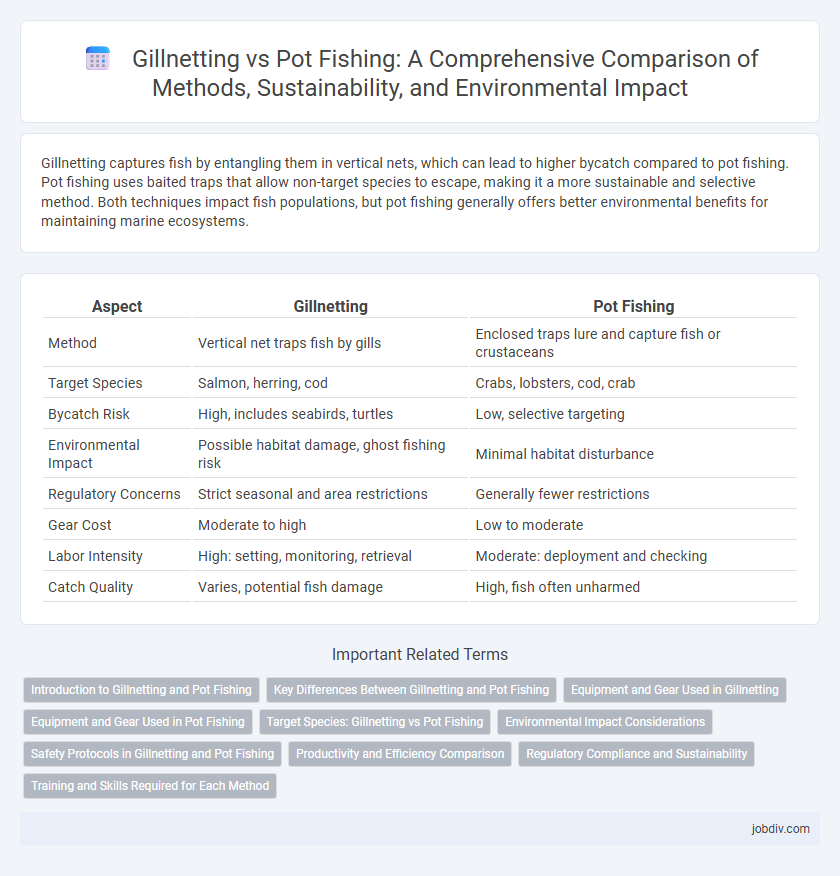Gillnetting captures fish by entangling them in vertical nets, which can lead to higher bycatch compared to pot fishing. Pot fishing uses baited traps that allow non-target species to escape, making it a more sustainable and selective method. Both techniques impact fish populations, but pot fishing generally offers better environmental benefits for maintaining marine ecosystems.
Table of Comparison
| Aspect | Gillnetting | Pot Fishing |
|---|---|---|
| Method | Vertical net traps fish by gills | Enclosed traps lure and capture fish or crustaceans |
| Target Species | Salmon, herring, cod | Crabs, lobsters, cod, crab |
| Bycatch Risk | High, includes seabirds, turtles | Low, selective targeting |
| Environmental Impact | Possible habitat damage, ghost fishing risk | Minimal habitat disturbance |
| Regulatory Concerns | Strict seasonal and area restrictions | Generally fewer restrictions |
| Gear Cost | Moderate to high | Low to moderate |
| Labor Intensity | High: setting, monitoring, retrieval | Moderate: deployment and checking |
| Catch Quality | Varies, potential fish damage | High, fish often unharmed |
Introduction to Gillnetting and Pot Fishing
Gillnetting employs vertical panels of netting that trap fish by their gills, making it highly effective for species like salmon and herring. Pot fishing uses baited traps placed on the seabed to capture crustaceans and demersal fish, minimizing habitat disturbance. Both methods vary in selectivity and environmental impact, influencing their application in sustainable fisheries management.
Key Differences Between Gillnetting and Pot Fishing
Gillnetting uses vertical panels of netting that entangle fish by their gills, targeting species like salmon and cod, whereas pot fishing employs baited traps that capture crustaceans and fish such as lobsters and crabs without harm. Gillnets can result in higher bycatch and habitat damage due to their non-selective nature, while pot fishing tends to be more selective and environmentally friendly. The efficiency of gillnetting is favored for open water fish populations, whereas pot fishing is optimized for benthic species in coastal and reef environments.
Equipment and Gear Used in Gillnetting
Gillnetting employs vertical panels of netting with monofilament or multifilament nylon mesh designed to entangle fish by their gills, supported by floats on the top and weights on the bottom to maintain vertical positioning in the water column. The gear includes strong, durable net frames, buoys for surface marking, and lead lines to anchor the nets on the seabed, making it highly effective for targeting species like salmon, herring, and cod. Unlike pot fishing, which uses baited traps or cages to capture crustaceans and bottom-dwelling fish, gillnetting relies primarily on the mesh size and material to selectively catch fish based on size and species.
Equipment and Gear Used in Pot Fishing
Pot fishing utilizes baited traps made from sturdy materials such as wire mesh or plastic to capture crustaceans and shellfish, contrasting with the fine mesh nets in gillnetting. These pots often feature escape vents and biodegradable panels to promote sustainable fishing and reduce bycatch. Durable lines and buoys are essential in pot fishing for marking trap locations and facilitating retrieval in various marine environments.
Target Species: Gillnetting vs Pot Fishing
Gillnetting primarily targets pelagic and demersal fish species such as salmon, herring, and cod by using vertical net panels that trap fish by their gills. Pot fishing is designed for crustaceans and shellfish like crabs, lobsters, and crayfish, utilizing baited traps that capture species without causing significant habitat damage. Both methods offer species-specific selectivity, but pot fishing typically results in less bycatch and environmental impact compared to gillnetting.
Environmental Impact Considerations
Gillnetting poses significant environmental risks due to bycatch of non-target species and habitat damage from lost or abandoned nets, contributing to ghost fishing. Pot fishing, by contrast, offers a more selective method with lower bycatch rates and minimal seabed disturbance, reducing negative ecological impacts. Sustainable fisheries management increasingly favors pot fishing to protect marine biodiversity and promote ecosystem health.
Safety Protocols in Gillnetting and Pot Fishing
Gillnetting requires strict safety protocols to prevent entanglement and drowning, including wearing personal flotation devices and maintaining clear communication among crew members. Pot fishing emphasizes safe handling of traps to avoid injuries from heavy equipment and uses secure stacking techniques to prevent deck hazards. Both methods mandate regular equipment inspections to reduce accidents and ensure compliance with maritime safety regulations.
Productivity and Efficiency Comparison
Gillnetting often yields higher catch volumes due to its ability to capture fish continuously over extensive areas, making it highly productive for species like salmon and herring. Pot fishing demonstrates greater selectivity and lower bycatch rates, enhancing efficiency by targeting specific species such as crab and lobster while reducing environmental impact. Evaluating both methods, pot fishing typically offers sustainable efficiency with minimal habitat disruption, whereas gillnetting prioritizes volume but may require stricter management to ensure long-term productivity.
Regulatory Compliance and Sustainability
Gillnetting faces stricter regulatory compliance due to bycatch concerns and habitat impact, with many regions imposing seasonal closures and mesh size restrictions to protect non-target species. Pot fishing is often viewed as more sustainable, allowing for selective harvesting and minimal seabed disturbance, leading to fewer regulatory constraints worldwide. Sustainable fisheries management increasingly favors pot fishing methods to align with conservation goals and minimize ecological footprint.
Training and Skills Required for Each Method
Gillnetting requires specialized training to understand net placement, mesh size selection, and timing to minimize bycatch and ensure sustainable catches. Pot fishing demands skills in trap construction, baiting techniques, and knowledge of species behavior to optimize capture rates. Both methods benefit from hands-on experience and regulatory awareness to comply with fishing laws and promote environmental stewardship.
Gillnetting vs Pot Fishing Infographic

 jobdiv.com
jobdiv.com